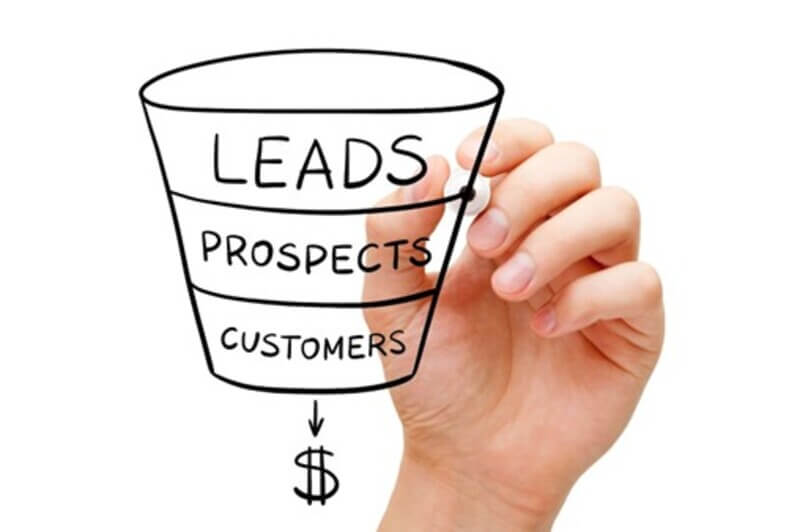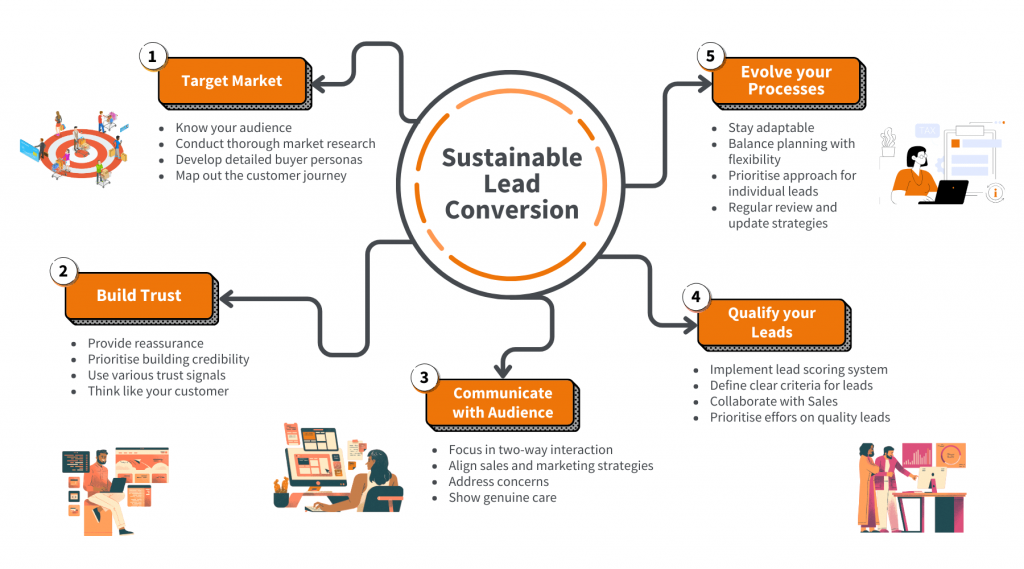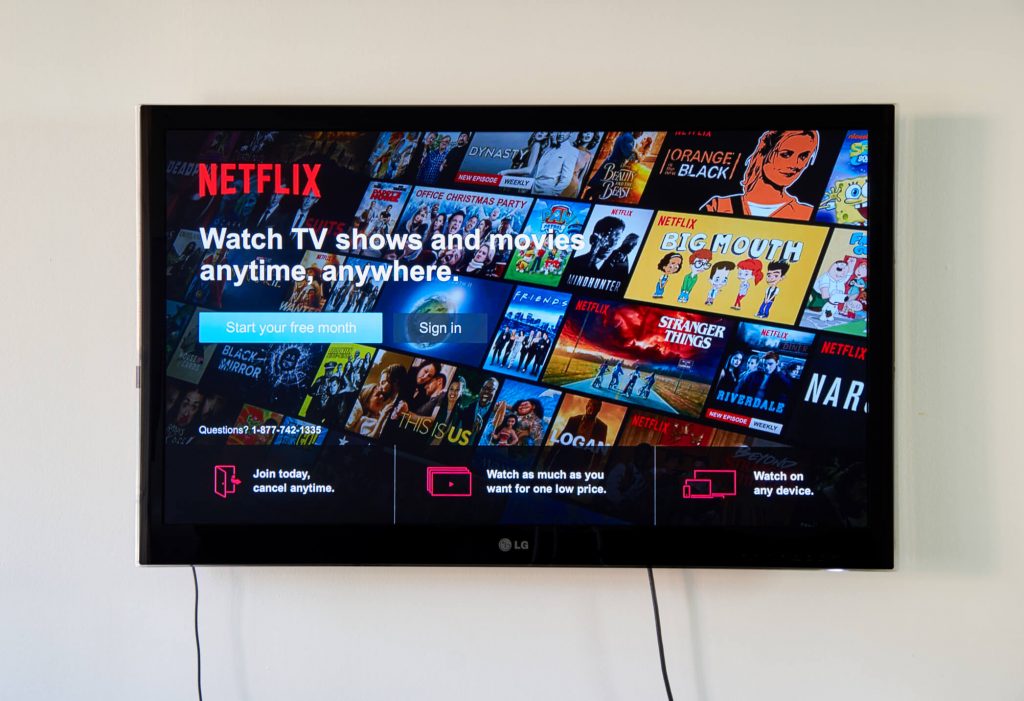Mel is our Partner Strategy & Delivery Manager and also a CIM Chartered Marketer, a testament to her commitment to excellence in the field. But Mel’s contributions don’t stop at the office door. Beyond her professional endeavours, she leads an active life as a qualified run leader and dedicated volunteer. Her experience in these roles has streamlined her leadership and teamwork skills, making her an invaluable asset when it comes to collaborating on projects and ensuring their success. Her sharp insights, strategic thinking, and knowledge have made her a backbone in our team’s ability to drive results for clients in this industry. Mel will make sure that we can approach marketing challenges from all angles and deliver outstanding results for our clients.
Posted on 22/11/2022 by Melanie Comerford
How To Convert Your Leads Into Sales
Updated: July 2024
Read Time: 11 minutes
In the marketing channel, generating leads is only half the battle. The real challenge? Turning those leads into paying customers. Did you know that the average conversion rate for a website is 2.35%? Even more startling, even the top websites only have a conversion rate of 11% or more. These statistics emphasise how mastering lead conversion is not just important—it’s essential for business growth and sustainability.
Imagine doubling or even tripling your conversion rates. The impact on your bottom line would be transformative and help you achieve bigger success in selling your products or services. In fact, according to a report, businesses that excel at nurturing leads generate 10% more responses compared to a general email campaign.
So, your landing pages and marketing channels are performing nicely, and you’re now generating a sustainable stream of leads to keep your sales team busy. That means your job as a marketer is done, right? Wrong! Your prospects may have transitioned from visitor to lead, but they’re yet to become customers of your business. The journey from lead to customer is where the real magic happens—and where many businesses falter.
Now, we appreciate that the buyer’s journey can be a complicated beast in its entirety, but it doesn’t need to be. Breaking down the buyer’s journey into smaller milestones will help you understand the process your users travel through to purchase. By looking at each milestone individually you’ll be better equipped to identify bottlenecks and recognise solutions for a seamless experience.
Let us look at a few ways to bridge the gap between lead to a customer with some great digital marketing strategies and tools.
What is an Effective Lead Conversion?

Lead conversion is the process of transitioning your users from leads to sales. The lead in this instance has already expressed an interest in your business by submitting a form or via a sign-up. Your lead conversion strategy is what follows, it should outline the steps required to influence your lead towards a purchasing decision.
Lead conversion, as outlined above, is traditionally the responsibility of your sales team. However, we’re in the zone of modern commerce, where sales and marketing teams work strongly together.

For many forward-thinking businesses, effective lead conversion strategies involve utilising marketing material to help stimulate a desire to purchase. Your sales and marketing departments often deliver these via various channels. Together, you can build an effective lead nurturing programme that will generate a sustainable stream of customers for your business.
Why Does Lead Conversion Matter?
The long and short of it is, If your leads didn’t convert, your business would not have any customers, including your existing customers who rely on you for continued service.
Arguably, a lead generation strategy and conversion is more principal for B2B businesses, where B2B lead generation is often subject to lengthy buyer’s journeys. However, the truth is, both B2B and B2C businesses can uncover the benefits of a solid lead conversion programme. This approach isn’t exclusive to a particular industry or niche either, brands across different markets can benefit.
The purpose of lead conversion is to support your business’s sales team in closing more deals. By understanding how your company can improve lead conversion, you can create a more effective sales funnel and accompanying marketing strategy. Both of which will be centred around increasing your brand’s revenue.
With a more efficient sales funnel, you can move your leads through your sales pipeline faster and with less legwork. Helping to keep your leads warm and nurture them with content when they’re ready.
5-Steps To Sustainable Lead Conversion
If you’re ready to turn those hard-earned leads into loyal customers? You’re in the right place! We’ve distilled years of marketing wisdom into five power-packed steps that’ll improve your conversion rates.

1. Understanding Your Target Market
Understanding your target market also helps you cater to existing customers, ensuring that your offerings meet their evolving needs. The key to securing new leads and ultimately sales for your business lies in defining exactly who it is your business is targeting and why.
By conducting comprehensive research into your target market, user segments and buyer personas your marketing strategy will commonly follow. Your market research should uncover unique insights about your target buyers which will form the foundation of their buyer’s journey.
In addition to plotting the buyer’s journey, you should also build a bigger picture surrounding the consumer’s needs, challenges and goals. You can then use these insights to craft high-impact marketing messages that can help seal the deal.
2. Establish & Build Trust
Now more than ever brands are required to work hard to win the consumer’s trust. Without this trust, it’ll be next to impossible to influence your users to make a purchasing decision.
By this stage in the buyer’s journey, your business should have already instilled a level of trust in your lead, otherwise, they wouldn’t be there. At this crucial stage, it’s all about tipping your user into a sale, a moment that rests on a knife edge. Depending on the scale or monetary value of the purchase, your user will require reassurance that they are making the best possible decision.
As a marketer, you need to think about what types of relevant content and trust signals would help influence your purchasing decision. Do you scour reviews, read testimonials or download trials? Consider which channels and tactics can help push that final vote of confidence to your lead.
3. Communicate With Your Audience
This one is predominantly relevant for your sales team, but there are some takeaways for marketers. Consumers don’t wish to be spoken to, we as people generally like to converse with others. Depending on your market, leads can be hard to come by, making them a commodity for your business.
How both your marketing and sales departments communicate with these leads will be the make or break of the sale. You want your leads to know you are there when they are ready, not to push them into being ready. Any hard-sell techniques will likely have your leads signing the dotted line with a competitor.
Both your sales and marketing communications should address your lead’s concerns and queries, helping to alleviate any potential barriers to purchase. In summary, you want to show your leads that you care and that you’re willing to work to get them onboard.

4. Qualify & Score Your Leads
Ever feel like you have too much to do, so much to focus on, yes? Welcome to the world of marketing! But seriously, there are a number of steps you can take to minimise your workload and prioritise the best opportunities. Enter lead scoring. The lead scoring tool enables you to identify the value and importance of a lead, the higher the score, the better quality lead.
To effectively lead the score, you’ll need to define criteria and allocate points based on these criteria. Consider looking at metrics like budget, company size and level of seniority to build your criteria. Whilst there are predictive lead scoring tools out there, we recommend defining this yourself. The best part is that you can work in collaboration with your sales team to give both sales and marketing scores.
Your lead quality should help you determine which leads deserve your time and resources. We recognise that so much time and other resources can be wasted by trying to nurture the ‘un-nurtureable’. Again, this is one primarily for your sales team but it will also help you as a marketer, focus your efforts on the right leads.
5. Remain Agile & Evolve Your Processes
Changes and shifts in consumer behaviour happen all of the time. Customer touchpoints, fast-changing competition and technological advances have made it increasingly more difficult to look ahead.
We are in no way suggesting that you shouldn’t plan, but you do need to cater for some flexibility within your plans. The most successful marketing strategies work by adapting your decisions to adapt to the market, allowing for different eventualities. The same applies to your lead nurturing programme.
To effectively convert your leads into sales, you need to cater and personalise your approach to the individual. You can do this by distributing the right and relevant content and sending the right contextual messages.
In our industry, nothing tends to stand still for long so remember to stay on your toes and be ready to adapt your approach as the market develops. As a rule of thumb, we recommend planning at least a quarter ahead.
The Best Strategies For Converting Leads Into Customers
Below we’ve outlined some of the most effective marketing strategies that can help convert your leads into sales.
Offer Demos & Trials

Does your business currently have a ‘try it for free’ system to help encourage your leads to become regular customers? Although this won’t be applicable to all businesses, you may be able to take some good ideas away from it.
Essentially, if you’re not familiar with the concept of demos and trials, it’s one of the best-performing calls-to-actions there are. Freemium models help give your users a taste of what your business can offer. There are various different ways you can configure this to work for your brand. In summary, however, these tools can be very effective in engaging your most qualified leads and converting them into sales.
Do bear in mind that depending on how you’ve configured your trial, you may want to consider creating a free-to-paid conversion strategy.
Share Case Studies & Testimonials
This strategy links back to what we were saying about building trust and providing trust signals. Recent studies suggest that up to 82% of consumers will read online reviews so don’t underestimate the power of providing social proof. This review could be the selling point for your business.
Case studies can be leveraged as a marketing and sales asset, but we highly recommend creating a dedicated webpage to host all of your case studies. Conditional to how your business operates, you may also want to consider adding a filtering system that helps users find case studies relevant to their business.
Implement Marketing Automation
Marketing automation is probably the latest addition to be thrown into the wider marketing mix. This innovation has been rapidly growing in popularity due to its low-cost, high-impact concept.
All businesses across various industries and markets fall victim to wasting time carrying out repetitive tasks. Marketing departments often bare the biggest part of this burden. Amongst other benefits, marketing automation is here to mitigate this.
When it comes to lead conversion, marketing automation can help automate sales processes, create tasks, organise contacts and prioritise activities. For marketing teams, automation helps send personalised messaging to the right leads at the right time. All of this helps to enhance the user experience, ensuring communication is contextual and relevant at all times.
Activate Retargeting Ads
Unlike regular PPC and display advertising, retargeting ads are only served to users who have previously visited your website or are a contact in your database. There are two ways that retargeting ads can be implemented, either by pixel-based targeting or list-based targeting.
If implemented correctly, retargeting ads can be used to move your qualified leads along to complete their buyer’s journey. Using list-based targeting, you can put together a group of highly qualified leads and send powerful messages about how your business can support them.
A number of channels will enable you to launch retargeting ads, whether it be via search through PPC or social media platforms. You should always aim to meet your leads where they choose to spend their time online.
Send Contextual Messages
We’ve noted this one throughout the majority of this article. Contextual messaging refers to several key techniques that are designed to deliver information directed by where the user is in their journey. Consumers now expect personalisation that goes beyond using their first name in an automated email.
Contextual communication enables brands to deliver the right message to the right people at the right time, effectively cutting through digital clutter and ensuring that your message reaches highly qualified leads based on their interests and behaviour.
Contextual communication can help deliver exceptional customer experiences and provide an edge over your competition. However, do ease into this on the side of caution as brands that get too personal risk making the user uncomfortable. This could cause your lead to duck out of their journey and opt out.
Loop Digital Marketing – Your Partner in Lead Generation and Conversion
At Loop Digital, we specialise in lead generation and conversion. As a leading digital marketing consultancy in the UK, we have assisted numerous businesses in transforming their marketing strategies into comprehensive lead-generation engines and efficient conversion systems. We provide a variety of different digital marketing services that can help build brand awareness, promote engagement and secure sales.
Our team of experienced professionals recognises that each business is unique, facing distinct challenges and opportunities in lead generation. Therefore, we provide customised strategies that align with your specific objectives, industry dynamics, and target audience. Whether you’re struggling to attract quality leads or finding it challenging to turn those leads into loyal customers, we have the expertise and tools to elevate your marketing game.
Book your free consultation today and schedule your session with one of our digital marketing experts. Let’s unlock the infinite possibilities of digital marketing for your business together!
Looking for your next opportunity?
Digital marketing careers
We’re always on the lookout for talented individuals to join our ever growing team. If you think you’d be a great match for Loop Digital, we’d love to hear from you.

Join 300+ business owners getting weekly growth strategies - subscribe now.
"*" indicates required fields







